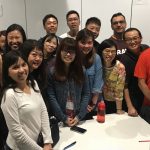So, I’m in the middle of our “Computational Design” workshop and suffering what I call “Generative Artists’ Block”. In other words, I can’t get the code to make the “art” that I want. So my mind wanders.
The “theme” I’ve got to work with this week is “The Procedural”. A common attribute of generative design, it’s about sets of rules that cause things to behave a certain way. These are the same kind of rules that make your washing machine handle delicates… programmed rules. I’ve been thinking about rules a lot lately, adjusting to life in Copenhagen, being back at school, moving into a new flat – I’ve had to learn a lot of new ones.
On my first visit here I noticed this, moving to a different city means learning new rules. Cyclists have separate traffic signals here, and a more complex set of hand signals than they do in Dublin. Paying in the supermarket everyone uses the little dividing bar on the conveyor at the till (and people get snappy if you don’t!). Video rental stores insist on getting your social security (CPR) number in order to let you rent a DVD. Jaywalking is faux pas.
I don’t know if it’s a personal thing, but when introduced to new rules, I often cringe at the new restrictions, question them, challenge the logic and often object or just outright break them if I don’t see the sense. I perceive rules as an assault on my own intelligence.
It works like this… you should let me judge if it’s safe to cross or not. I know I can navigate traffic on my bike, I don’t need your help. You should allow me to rent DVD without asking for excessive collateral. I’m smart, I evaluate situations, sometimes your rules assume I don’t.
People are smart. We should remember this.
I’m writing this as a kind of memo – remember when to use rules, credit people with intelligence, encourage them to use it.
One relevant example is the Shared Space concept in Urban Design. By removing traffic signals, road markings and other “rules” perceived as necessary, accidents can be reduced. Road users begin to think more, apply their intelligence and consider each other with more empathy.
More subtly, good interface design requires an awareness of the intelligence of the user. Humans calibrate things without even thinking – mouse moves on desk, cursor moves on screen. These distances are different but users can cope, a rule or known scale is not needed. The system is flexible, and therefore facilitates and “expert” and a “novice” user through the adjustment of a single parameter, speed.
I’m sure there a buckets of papers I could read about this. I’m not going to do so in a hurry.
At the same time, rules are sometimes necessary. Like when the dishwasher was working intermittently over the past few weeks in our shared kitchen. There were regular shortages of plates and glasses before a rule was introduced… “The dishwasher is broken, wash everything you use, straight away.” Confusion was eliminated and the system began to work.
So, be careful about rules, I’d like to try avoiding them as much as possible. Carrot instead of stick. We’ve got People Centred Design coming up… maybe this will apply then. In the meantime, I’m gonna continue coding, and jaywalking in Copenhagen.




Comments by John Lynch
Copenhagen to London
"Miguel - so happy you enjoyed the talk. While this post is..."